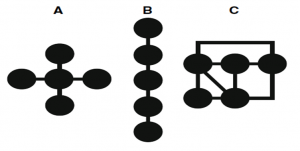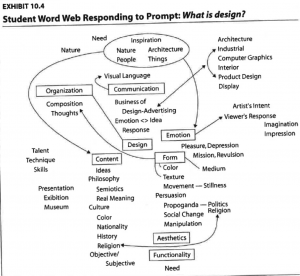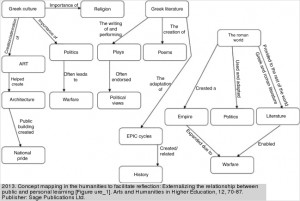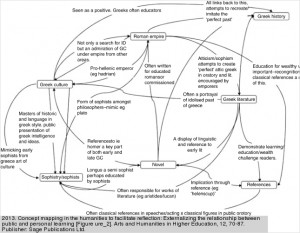Beyond the Essay, II
Formative Activities: Snapshots of Learning in Process
Concept Maps & Word Webs || Word Clouds
As Bass noted in his Visible Knowledge Project work with faculty, what “most interested—or eluded—them about their students’ learning” involved the “’intermediate processes’” that occur before students write a paper or take an exam. They were particularly eager to “gather information not available from finished products such as papers or ephemeral evidence such as class discussion, which they could not study reflectively” (Bernstein & Bass, 2005, p. 39). These earlier stages in learning are often hidden, kept private in the students’ minds, leaving faculty to assume or guess what students think and know—or don’t.
This capturing of the learning-in-process is the goal of formative assessments, or low-stakes activities used to identify learning, gaps, and confusion well before the higher-stakes, summative assignments of essays, exams, and the like. This guide from the CFT offers a variety of such assessments (commonly called “CATs,” classroom assessment techniques), but one is particularly effective at making visible these rich, elusive, telling moments: concept maps.
Concept Maps & Word Webs
Students diagram their emerging frameworks, arguments, or narratives of personal understanding
Concept maps are diagrams of how students connect ideas, particularly effective at “externalizing and making visible the cognitive events of learning” (Kandiko, Hay, & Weller, 2012, p. 73). Word webs is an alternative term, most commonly used for concept maps made in collaborative groups (Barkley, Cross, & Major, 2005, p. 226-231). These “cognitive events” include making and defining connections, demonstrating hierarchies or chronologies, developing ideas through support and examples—and, when juxtaposing earlier and later concept maps, working out individualized frameworks of understanding, building an argument, forming more complex syntheses of ideas, and showing changes in thinking.

Developed for biology classes, concept maps are often scored quantitatively: thinking of each map as a spoke or a chain (outlined as A and B to the right), its quality is measured in the accuracy and comprehensiveness of its hierarchy of ideas and number of links (Kandiko, Hay, & Weller, 2012, p. 74). They can also be assessed qualitatively by thinking of them as networks (C, right), evaluated by the accuracy, quality, and complexity of their connections and interconnections (Hay, Wells, & Kinchin, 2008, p. 224). This latter purpose is perhaps one reason for the alternative term, “word webs.”
Even further, comparing two or more maps or webs by the same student can make visible changes in thinking—additive or “assimilative” thinking in which students incrementally map new ideas onto old ones, or conceptual thinking in which students eventually revise and build their own their structures for understanding a concept. Kandiko, Hay, and Weller’s “Concept Mapping in the Humanities to Facilitate Reflection: Externalizing the Relationship between Public and Personal Learning” (2012) focuses on this latter, conceptual approach, which they note is closer to the ways of constructing knowledge in the humanities. Progressive maps or webs can document “continual processes of rehearsal, revision and reflection among theory, argument and debate,” or “recreating meaning and personal understanding” (p. 77-78). The authors illustrate with a case study from a Classics course in which students were simply asked to make three concept maps—in the beginning, middle, and end of the semester—of the overarching course topic, “’The impact of Greek literature and culture on the Roman world’” (p. 74).

Unlike the original use of concept maps to assess comprehension and additive knowledge in biology classrooms, this approach uncovers the shift from a student’s public reproduction of others’ ideas and patterns to the process of creating the student’s own conceptual frameworks, arguments, and stories of the discipline.
To the right is an example of a word web–similar to a concept map but with more emphasis on words and networks.
Resource
- “Concept Mapping in the Humanities to Facilitate Reflection: Externalizing the Relationship between Public and Personal Learning” (2012) by Kandiko, Hay, and Weller is a solid analysis of how concept maps are useful in the humanities and the source of the examples above.
Word Clouds
Students visualize and analyze shifts in their own understanding
Word clouds are visual representations of words emphasized by frequency. Like concept maps, individual word clouds document hierarchical thinking, in the sense of the words that are the most frequent (and thus largest) are presumably the most important–a very simple quantitative assessment. Also like concept maps, progressive examples can illustrate shifts in thinking. For example, a student could create a word cloud of earlier thinking (a written brainstorm, a blog post, an essay) and another of later thinking, and then reflect on the differences between the two. This analysis of the student’s own movement measured simply by word frequency initiates an act of more sophisticated metacognitive self-reflection: “How has my thinking about this concept changed?”
The same activity can be used for the entire class to demonstrate changes in thinking over the course of the semester. For instance, below are word clouds from a literary and film course on monsters from the first and last days of class is in response to the question, “What is a monster?” Students were then asked to analyze the two word clouds and articulate how the class’s understanding of monsters had changed during the course.
|
|
Resource
- Create word clouds with the Textal iPhone app.
| Introduction | Formative Activities: Snapshots of Learning in Progress | Summative Assignments: Authentic Alternatives to the Essay | ||
|
|
—-
References
Barkley, Elizabeth F., Cross, K. Patricia, & Major, Clair Howell. (2005).Collaborative Learning Techniques: A Handbook for College Faculty. Jossey-Bass: San Francisco.
Bernstein, Dan, & Bass, Randy. (July/August 2005). The Scholarship of teaching and learning . Academe, 91(4). 37-43.
Hay, David B., Wells, Harvey, & Kinchin, Ian M. (2008). Quantitative and qualitative measures of student learning at university level. Higher Education, 56. 221-239.
Kandiko, Camille, Hay, David, & Weller, Saranne. (2012). Concept mapping in the humanities to facilitate reflection: externalizing the relationship between public and personal learning. Arts & Humanities in Higher Education, 12.1. 70-87.

This teaching guide is licensed under a Creative Commons Attribution-NonCommercial 4.0 International License.




